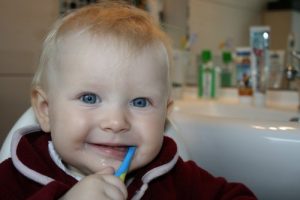When and How to Start Brushing Your Baby's Teeth

When do you start brushing your baby’s teeth? It is a question that every mother has asked at some point. Logic leads you to believe that you should start cleaning your baby’s teeth as soon as they appear, however some people believe that a baby’s gums should be cleaned before their first baby teeth emerge.
When your baby’s teeth emerge, you can start using a tiny toothbrush that only has two or three rows of soft bristles. You can also consult your paediatrician about the type of toothpaste they recommend.
The American Academy of Dentists recommends using very small amounts of toothpaste. They recommend using toothpaste comparable to the size of a grain of rice, with fluoride; A mineral that strengthens tooth enamel making it more resistant to cavities.
How to clean a baby’s teeth?
You should keep in mind that fluoride can be dangerous for children if they ingest it in large quantities. In order to prevent issues, store toothpaste out of the reach of your baby. Too much fluoride can also cause dental fluorosis. Fluorosis is a type of tooth discoloration. So keep an eye out.
“A baby is a blank check for the human race”—Barbara Christine Seifert
When children get a little older, the main problem is convincing them that it is good to brush their teeth. Don’t worry, this is normal and transitory, you will overcome this with a little patience.
From the emergence of the first teeth it is important to start with good dental hygiene habits. Clean the first teeth and molars two or three times a day or after each meal. Use a little cloth of gauze moistened with water to clean the teeth and gums gently.
When they are 12–18 months old, you can start using a special toothbrush for children. You can pick one that the child prefers, preferable a small one that they can handle. Always under your supervision. Do not leave them alone, because at this age they still have not developed the hand-eye coordination to brush without assistance. It is good for them to practice and become familiar with how to brush their teeth.
There are also toothbrush models that an adult can insert over their finger for better mobility. It is important that the brush have soft and flexible bristles. In the first couple of months you can even brush your baby’s teeth and gums with only water.
When they get older
From ages 2 and up you can start using small amounts of toothpaste. When they first start brushing their teeth it is best to use toothpaste that doesn’t contain fluoride. This will prevent the baby from harm if they mistakenly swallow some toothpaste.
There are special toothpastes that are made specially for children. They are made with natural ingredients and do not contain fluoride. Read the indications on the back of the toothpaste before use to make sure it can be used with children.
It is a good idea to have your baby watch you while you brush your teeth. By curiosity or imitation they will want to do the same. They will also associate brushing as a daily habit. There are songs and games that you can play in front of the mirror to make the routine of brushing teeth fun. This will encourage them to take care of their teeth.
From the age of 3 up, when they have already learned the mechanism of brushing teeth and spitting out the toothpaste. You can begin to trust their autonomy and slowly start to increase the amount of toothpaste they use. At this age they can also start using the same toothpaste that the rest of the family uses.
When the rest of their teeth start to emerge, you can help the floss gently. Your dentist who you should have visited on several occasions since your child reached 1-year old will guide you on the best way to preform this task.
Whatever the case, do not forget to go to your dentist for regular checkups. Especially if you notice any kind of abnormality when their teeth emerge. You should also inform your dentist if you notice any bleeding gums or cavities.
This text is provided for informational purposes only and does not replace consultation with a professional. If in doubt, consult your specialist.
